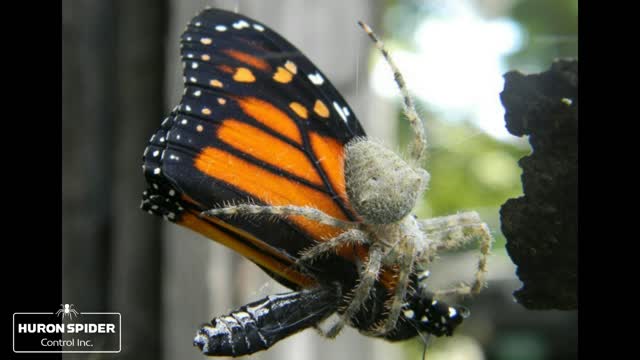Premium Only Content

ARANEUS CAVATICUS
Araneus Cavaticus, also known as a barn spider or common house spider, is an orb-weaving, nocturnal species that is indigenous to North America.
Being orb weavers, their webs are flat and spiral-shaped, made of sticky threads to capture prey and support the structure of their webs.
The webs are mostly spun by the females, who take their webs down during the day and rebuild new ones every evening. At night they wait in the middle of the web, waiting to attack prey that enters it.
Their prey includes crickets, cockroaches, beetles, ants, moths, flies, and even mosquitos.
Their common predators are birds and other spiders.
They can be found living in many different habitats, such as in trees, shrubs, houses, cottages, and boats, and are seen during late summer and throughout fall.
Their egg sacs are made using silken thread resembling a cocoon. A single sac can contain hundreds of eggs that are round or disc-shaped.
Once the spiderlings leave the egg sac, they become independent within a short time after hatching.
The adult Araneus Cavaticus is a relatively large, hairy, spider species, that has a spherical body shape, with numerous small humps and long legs that allow them to move quickly.
Adult males are smaller than females in size and measure approximately one-quarter inch long, whereas the larger female, measure approximately one-half inch long.
These spiders are yellow or brown, with grey or dark stripes on their legs. The lower part of their body is black with white markings.
They are not poisonous as their venom is said to be nontoxic to human beings. However, their bite might be equal to a bee sting, causing redness and irritation in the affected area.
They live for approximately one year.
We hope you enjoyed our summary of the Araneus Cavaticus.
-
 LIVE
LIVE
Dr Disrespect
7 hours ago🔴LIVE - DR DISRESPECT - PUBG - WHAT WINNING LOOKS LIKE
5,040 watching -
 LIVE
LIVE
Nerdrotic
3 hours ago $7.74 earnedCap 4 and Emelia Perez BACKLASH! Acolyte is Still CANCELED! Hollywood STFU | Friday Night Tights 339
6,343 watching -
 LIVE
LIVE
The Jimmy Dore Show
2 hours agoTulsi SHREDS Intel Agencies in Senate Hearing! Jon Stewart’s Anti-China Propaganda! w/Elaine Culotti
18,672 watching -
 LIVE
LIVE
Afshin Rattansi's Going Underground
1 day agoMax Blumenthal on US’ Ukraine Aid Corruption, 'Psychotic' Israel Turning the West Bank into Gaza
375 watching -
 UPCOMING
UPCOMING
Sarah Westall
1 hour agoUnited States in a Two Front War, Identify Military Psyops and Special Operations w/ Jeffrey Prather
373 -
 UPCOMING
UPCOMING
Quite Frankly
4 hours ago"Open Phones: D.C. Crash, Senate Hearings, Petty Break-Ups" 1/31/25
1.4K -
 UPCOMING
UPCOMING
2 MIKES LIVE
4 hours ago2 MIKES LIVE #173 Open Mike Friday!
83 -
 UPCOMING
UPCOMING
LFA TV
7 hours agoDemocrats’ Greatest Fear Is Accountability | TRUMPET DAILY 1.31.25 7pm
1.09K -
 23:15
23:15
Bare Knuckle Fighting Championship
1 day agoBKFC FIGHT NIGHT MOHEGAN SUN FREE FIGHTS
6.88K -
 5:49:46
5:49:46
Bitfinex
7 hours agoBitfinex Talks Live at PlanB El Salvador - Day 2
11.7K1